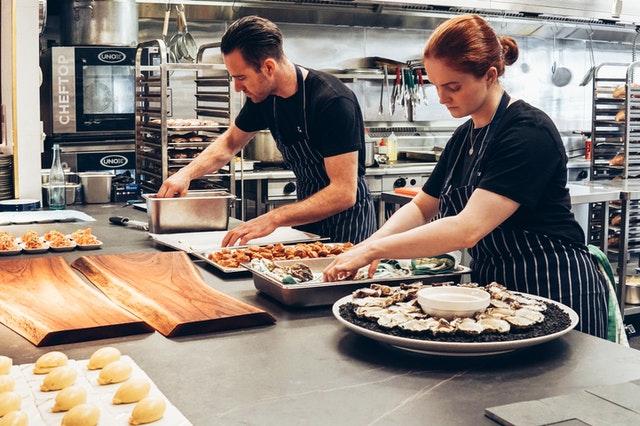Tactics to Help Your Small Restaurant in Turbulent Times

Whether you’re opening a restaurant this year or you’ve been in the business for a long time, any operator can heed the advice of longtime industry experts. It’s hugely important for getting a leg up on the competition and preparing for battle armed and educated.
The last few years in the industry have been nothing short of turbulent. Operators are now finding their way back to steady ground, discovering the game has changed entirely. While some obstacles remain the same, others are a new challenge. From COVID impacting supply-chain disruptions to unprecedented labor shortages, and the constant burden of inflation, even the most seasoned operators have their work cut out for them this year and beyond.
Know Your Key Restaurant Accounting Metrics
Before an operator can determine how best to mitigate unforeseen obstacles that arise throughout the year, they must first have knowledge of the key performance indicators that ensure their restaurant runs smoothly in the first place. These KPIs are a critical roadmap for an operator.
We’ve outlined a few basic metrics below that are essential to the success of any restaurant operation.
1. Restaurant Profit Margin
Average profits across the restaurant industry differ from restaurant type, but the typical range is 2%-6%. There are two ways to classify profit margin. The first is gross profit. This subtracts only your COGS (cost of goods sold). The second is net profit, which removes all your expenses.
The standard formula to calculate your restaurant profit margin as a percentage of sales is:
[(Revenue – Expenses) / Sales] x 100
This metric is vital for operators to both understand and track. Knowing how much money flows to the bottom line helps inform operators of their progress and guides them in better decision-making.
2. Restaurant Break-Even Points
Break-evens are one of the most sound principles in guiding profit margin. They indicate the amount of sales required from your business to meet your fixed and variable costs. Moreover, break-evens help operators create more accurate budgets (operators cannot survive without a solid budget to which they closely adhere) and sales forecasts, ultimately improving the bottom line.
There are two categories of break-evens. A cash flow break-even and an operational break-even. A cash flow break-even factors in your restaurant profitability plus your debt servicing, government assistance, and anything else that does not show up on your P&L but should still be considered in your cash management strategy. An operational break-even assists in determining at what point your sales meet your complete operational expenses. This type of break-even assists in determining budgets, goals, and operational directives.
3. Overhead Costs
Your overhead is the ongoing business expenses you incur each period that do not significantly change in terms of cost. Your overhead expenditures include rent, salaries, utilities, and advertising. It’s essential to understand your overhead rate because the lower your overhead, the greater your profit margin.
The following formula calculates overhead rate for a given period:
Total Fixed Costs / Total Operating Hours.
4. Labor Costs
As the most significant expense to your restaurant, and one of your Prime Costs, it’s evident why you must monitor this labor metric closely. Labor Expenses are broken into operational payroll costs (FOH/BOH hourly wages), and your remainder payroll costs (salaries, payroll taxes, employee benefits, and employee discounts).
To calculate your Labor Cost Percentage, you take your Labor Dollars / Sales. Reviewing labor data consistently lets operators view business trends and schedule their staff more efficiently. Operators can also control their labor costs through reporting with overtime warnings, time and attendance details, server productivity, and more!
5. Cost of Goods Sold (COGS)
Your COGS is the first Prime Cost area on your P&L. Like labor, it takes up a significant amount of a restaurant’s overall expense and is vital to manage closely. The formula to determine your COGS is as follows:
(Opening Inventory + Purchases – Credits – Ending Inventory) / Sales.
Commodity prices will always fluctuate, therefore, it’s essential to nail down proper strategies to control COGS, such as, inventory tracking, W.E.P.T tracking (waste, error, portioning, theft), and actual product usage.
6. Prime Costs
It’s crucial that operators tightly control their principal cost drivers, i.e., Prime Costs: labor and COGS. Operators who consistently evaluate their Prime Cost KPIs make better business decisions based on data.
Beyond the individual Labor and COGS cost control strategies mentioned above, operators should pay close attention to the following: payroll compliance (to avoid costly fees), menu engineering (to optimize your menu from a financial perspective for more profitable dishes – this is also a great way to improve restaurant sales) and leveraging vendor relationships to ensure they’re getting the best deals on all products (including food, disposables, linens, chemicals, etc.).
7. Financial Statements
While not technically a single metric, understanding each of your restaurant’s financial statements contributes to the overall larger picture of success. Every operator must consistently review their Profit and Loss Statement, Balance Sheet, and Cash Flow Statement. While each statement measures a different aspect of the restaurant, all of them combine to highlight the overall health of your restaurant.
Frequent reviews provide operators with the leverage needed to make educated business decisions. They can track departmental performance relative to budgeted goals, assess sales trends and forecasting accuracy, and evaluate their primary cost directives. Ultimately, timely and accurate financials empower operators to drive positive, consistent financial results.
Mitigate These Restaurant Industry Trends With Expert Tactics
1. Supply-Chain Disruptions
It’s no secret that disruptions in the supply chain have affected practically every industry. It’s also no secret that restaurant operators heavily rely upon their vendors to ensure their day-to-day operations can proceed without a hitch and they can turn a profit. Unfortunately, these two facts have made for a challenging obstacle that all operators are trying to overcome. Luckily there are still a few strategies that operators can follow to alleviate the pains of supply chain kinks.
- Restaurants should try to switch to a single distributor. This enables them to form a stronger relationship with one party and strategize together.
- Operators should review their current delivery day to analyze if there’s a better day for delivery that works for the distributor. Working with distributors to review driver routes to determine when trucks will be in the area is key for success.
- Operators can give distributors more time to fulfill orders or communicate sub-items if they simply order early. As a bonus, orders that are placed first are typically filled first.
- Every operator should evaluate their inventory levels and see where they can make some wiggle room with bulk items (think non-perishable items like dry goods).
- Foster turnkey deliveries. This enables the distributor to deliver when it’s most convenient for them while satisfying the needs of the operator as well.
2. Restaurant Employee Turnover and Labor Shortages
An additional restaurant industry trend we’re seeing in 2022 is not only a labor shortage but also high restaurant employee turnover. When strategizing to overcome these problems, operators can rest assured that they go hand-in-hand. By improving your hiring practices, you’ll be looking in the right places to find better-qualified candidates who will then stay for the long haul.
- Utilize an Applicant Tracking System. ATS solutions streamline the hiring process from recruiting to onboarding, ensuring the candidate experience is branded and elevated.
- Ensure you understand what roles you need to fill and write job descriptions that set the expectations for each function from the get-go. You’re setting precedence for what your business needs, so there is no confusion down the road, reducing restaurant employee turnover.
- Rely on data to understand where the best quality job traffic lives and post on those forums. Don’t waste your time posting anywhere and everywhere.
- Ensure you’re thoughtful in your interview questions to understand a candidate’s personality and skillset. Hiring for fit over function is always the better risk to take as you can teach skills, but you can’t force someone to mesh with your current culture if they’re simply not a fit.
- Lastly, offer competitive benefits to help you stand out from the competition. Reducing restaurant employee turnover comes with showing your employees that you value them.
3. Inflation
While not a new restaurant industry trend in 2022, inflation is trending, possibly the highest within commodities we’ve seen in years. As operators are all trying to get a secure handle on their COGS, this issue remains at the forefront of their tactical to-do list. Here are strategies that can assist in relieving some of the burn.
- Focus on your top-selling menu items and review their contributed margins, and work with your vendors on the specific items that have the most significant impact on your margin.
- Attempt to “lock-in” future pricing based on historical purchases and menu item sales
- Rework recipes whenever possible.
- As a last resort, increase menu item pricing, but only do it on the top-selling items because they have pricing elasticity.
- Bonus: if it doesn’t sell, it doesn’t belong on the menu.
by Matt Vannini
RASI CEO & President

A fourth-generation restaurateur who is well versed in the restaurant industry. After successfully running and eventually selling his own operations, went on to work for Corporate Red Robin, training on-site GMs on effective restaurant management and operations. Previously worked for Aloha POS as a Program Manager, increasing knowledge of BOH software and how to effectively integrate such systems into everyday operations. You can find him on LinkedIn here.



